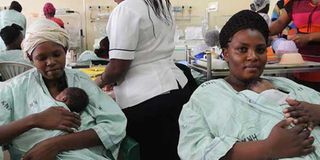The key to saving preterm babies

Mothers performing Kangaroo care at the KNH newborn unit. Most preterm deaths occur within the first three days of life. PHOTO | FILE | NATION MEDIA GROUP
What you need to know:
- Oftentimes, their source of solace is the health worker attending to them, be it a midwife, nurse, clinical officer or obstetrician.
- Prematurity is a very common occurrence, affecting more than one in 10 babies born globally.
- In low-income countries, 50 percent of babies born before seven months die within the first few hours of life.
Having served as a paediatrician for most of my adult life, including over 25 years as a perinatal/neonatal medicine specialist, I know first-hand the joy and anxiety that comes with giving birth.
For first-time mothers, especially, even as they eagerly anticipate the birth of their babies, they are scared – of pain, of complications that may arise, of the unknown.
Oftentimes, their source of solace is the health worker attending to them, be it a midwife, nurse, clinical officer or obstetrician.
This is more so the case when their baby is born premature, that is, before 37 weeks of pregnancy. Babies born premature are among the most vulnerable anywhere in the world. This is because their vital organs, such as lungs, brains and heart, are under-developed, and they sometimes require extra care and support to survive.
Prematurity is a very common occurrence, affecting more than one in 10 babies born globally.
NEWBORN DEATHS
Preterm birth is also the leading cause of newborn deaths around the world. In Kenya, we lose about 11,000 of the 134,500 babies born too soon. Yet, most of these deaths – 75 percent – can be prevented with the right care for mothers and newborns. The secret lies in equipping, training and empowering health workers.
Saving preterm babies begins with ensuring health workers have access to essential supplies.
Most babies develop mature lungs after 34-36 weeks of pregnancy. The majority of babies born before this time have lungs that are not yet fully mature. Health workers can administer steroids that speed up the development of lungs, especially when early deliveries are anticipated and the intervention provided 24 hours before birth.
EMERGENCIES
Most preterm babies are born with minimal body fat, making it harder for them to keep warm.
Health workers ensure the babies have access to incubators or skin-to-skin contact with their mothers (Kangaroo Mother Care) to prevent hypothermia.
Building the skills and confidence of health workers to identify and respond to birth emergencies is key.
In some countries, health workers have been trained to use the World Health Organisation’s Safe Childbirth Checklist. It outlines 29 essential steps that a health worker needs to take from the time a mother comes into a health facility ready to deliver to the time she is discharged.
These simple steps, such as washing hands, giving antibiotics where necessary, initiating breastfeeding and encouraging Kangaroo Mother Care, ensure that mothers and babies receive the best quality of care possible.
The checklist is a powerful tool tailored to address the main causes of maternal and newborn death, such as haemorrhage in mothers and complications related to prematurity.
Constant, hands-on training ensures that health workers are equipped with the latest information and have the skills to act quickly on birth emergencies.
PRONTO
PRONTO is a highly-innovative training model where nurses and doctors work together to solve simulated birth emergencies.
This low-tech model acts as a constant refresher course in Emergency Obstetric and Neonatal Care (EmONC) and encourages better communication between doctors and nurses during high-stress situations.
In a study conducted in Kakamega, PRONTO training was shown to reduce the proportion of newborns who die within the first week of life by 30 percent.
The study shows that on-the-job training not only sharpens health workers’ skills, it also gives doctors, nurses and clinical officers the confidence to act on conditions that threaten the lives of mothers or their babies.
In low-income countries, 50 percent of babies born before seven months die within the first few hours of life.
In high-income countries, almost all these babies survive because of access to basic care.
UHC
As Kenya journeys towards Universal Health Coverage (UHC), care for the smallest and most vulnerable must come first.
There will be no UHC without a significant reduction in neonatal mortality.
While the government builds new facilities and equips them and, health workers also have a role to play.
Most preterm deaths occur within the first three days of life.
Newborns need us, health workers, the most during that critical window of time.
As health workers, we must dedicate our skills and energy to saving babies born too soon. Some 11,000 preterm deaths a year is too many lives lost. World Prematurity Day, November 17 is an apt reminder of the battle that lies ahead of us.
Dr Were is a professor of Perinatal/Neonatal Medicine and former Dean of the School of Medicine at the University of Nairobi. [email protected]




